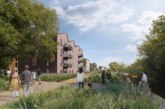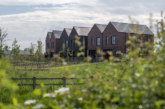
Rob Woolston, Director at multi-disciplinary design practice rg+p, discusses the growing popularity of modular building and whether it can make a significant contribution to the UK housing market.
Modular construction is generating a conversation in the industry and it would seem there is an increasing appetite to explore this method as a way of addressing the housing shortage. According to research* by Pinsent Masons, circa. 15,000 modular homes are built in the UK every year but this is just a tiny fraction of the overall total needed. So what’s happening and should we be encouraging more homes to be designed and built in this way?
There’s still some negativity around modular building, harking back to the days of pre-fabrication and the perception that these homes lack an aesthetic appeal or any long-term durability. Whilst it’s understandable there is a reluctance from traditional housebuilders to adopt this method in practical, financial and contextual terms, there’s definitely been more willingness from private developers and local authorities to explore modular, especially for affordable and build to rent (BTR) homes where it can offer a faster return on investment.
Recent news stories indicate confirmation of this. In June, Worthing Borough Council approved a scheme of 162 modular flats to be built as part of a collaboration between Ikea and Skanska**; demonstrating an ambition to catch-up with our European counterparts who are delivering similar and much larger scale modular homes successfully. Derbyshire-based manufacturer, TopHat secured a £75m investment from Goldman Sachs to expand its business***, again demonstrating a global appetite for this type of product.
Flexible solution
So how do we, as architects, master planners and urban designers, interpret this housing for modern living? Modular housing offers considerably more flexibility, and is no longer bound by a predetermined, homogeneous design but obviously there are still restrictions to consider; surroundings, production, transport and plotting.
Modular building can help overcome labour, skills and materials shortages but it doesn’t yet eradicate traditional build processes such as groundworks. So even though the gap appears to be narrowing, it’s still not a true alternative.
This being said, there’s certainly a growing confidence it can become more viable. Homes England welcomed the Goldman Sachs/TopHat investment and is actively promoting the use of modular development in the creation of affordable homes. In fact one of the local authorities to pioneer this type of construction following Homes England funding was Nuneaton & Bedworth Borough Council (NBBC), one of our longstanding clients. A successful pilot means NBBC is now looking to develop more sites in this way as it enables the delivery of high-quality affordable homes in a much-reduced timeframe.
With this support and advances in technology, modular homes are becoming more relevant. It’s therefore realistic to expect to see more widespread use and an acceptance from the industry that this is an alternative to be reckoned with.
* Source: Pinsent Masons: Modular Construction in UK Housing – An Overview of the Market, the Players and the Issues, February 2017
** Source: Worthing Herald, 05/07/19, https://www.worthingherald.co.uk/news/politics/worthing-set-for-more-than-160-ikea-flat-pack-affordable-homes-1-8953360
*** Source: Inside Housing, 11/04/19, https://www.insidehousing.co.uk/news/news/goldman-sachs-invests-75m-in-offsite-house-builder-60990









